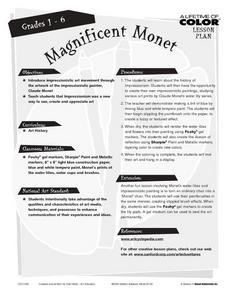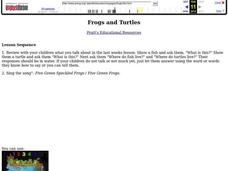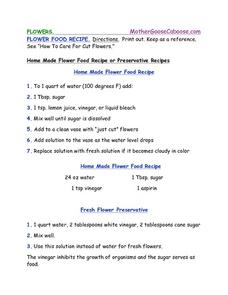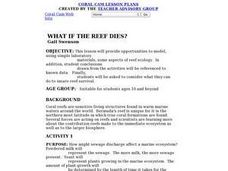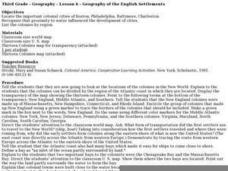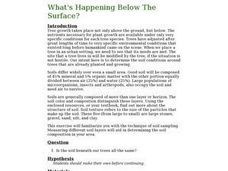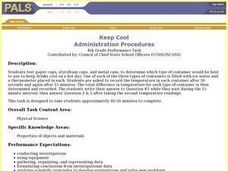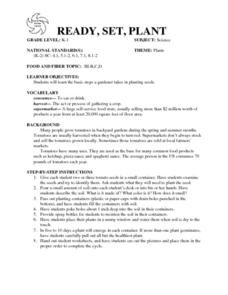Curated OER
Chlorine-Bleached Paper
Students analyze the effects of pollution and other types of ecosystem devasation caused by chlorine. They examine alternative technologies that allow for the bleaching of paper without using chlorine. They discover what they can do to...
Curated OER
Paper Chromatography
Students participate in an experiment determining how to separate a mixture of dyes in water-soluble ink.
Curated OER
Magnificent Monet
Students research the water lily paintings of Claude Monet and the impressionistic art period. They create their own impressionistic art works and display them in the classroom.
Curated OER
Watery World
Students brainstorm to develop resource/reference charts for later use. they are introduced to Microsoft Word and to an internet movie site. They use prepared chart headings, to respond to questions posed on each chart such as: Where do...
Curated OER
It's Not My Problem!
Young scholars examine how rivers flow through the country to sea level. Students study how upstream pollution effects the water and people downstream.
Curated OER
Soil Permeability & Texture
Pupils investigate types of soil to test their water permeability. They collect soil samples, make predictions, conduct the experiment, and answer conclusion questions.
Curated OER
Solubility and Chemical Changes in Groundwater
Students test pH of water before and after it travels through different substrates (igneous pebbles and limestone) to detemine how soluble materials can affect groundwater. They answer questions such as: What happended to the pH of the...
Curated OER
Frogs and Turtles
Students notice differences between frogs and turtles. In this frog themed lesson, students review what frogs are and practice counting to five with the help of music and a coloring worksheet.
Curated OER
Down the Drain
Students examine the following concepts: If water supplies contain materials which rot or decompose, oxygen is used. Decay and decomposition require vast supplies of oxygen. The use of oxygen for decay of wastes may be a life or death...
Curated OER
Flower Food
In this flower learning exercise, students create home made flower preservatives. Ingredients include water, sugar, lemon juice, vinegar, or liquid bleach.
Curated OER
Chemistry: Egg Sucking Experiment
Students discover simple gas laws by observing an egg sucked into an Erlenmeyer flask. When the flask is warmed, the egg is placed atop it. when both are placed in ice water, the egg slips into the flask. The procedure is then reversed....
Curated OER
Twisters
Learners differentiate between the terms 'tornado watch' and 'tornado warning' and simulate the conditions that produce tornadoes. They read "Night of the Twisters" by Ivy Ruckman and conduct an experiment using two-liter plastic...
Curated OER
Making a Region Map of a State
Fourth graders create salt maps of a state and indicate its regions. They include topographical elements including mountains, valleys, lowlands and major water bodies and a compass rose.
Curated OER
Recycling
Students examine different "cycles" that are found in nature, such as the water cycle and recycling. They create their own artwork about cycles to be displayed on a bulletin board
Curated OER
What If the Reef Dies?
Students complete four activities to investigate how reef ecology can change. They perform experiments to show how sewage discharge can affect a marine ecosystem, look at substances that don't dissolve in water, examine wave action...
Curated OER
Geography of the English Settlements
Third graders locate several important American colonial cities on a map and research how their proximity to water and nearby arable land affected the rate and success of settlement.
Curated OER
Food and Fiber: Helping the Environment and You
Fourth graders explore the many uses of corn-based products and the importance of water resources. They consider how biodegradable products help to keep water clean. They perform experiments to observe how corn pellets dissolve while...
Curated OER
What's Happening Below The Surface?
Students determine the soil composition of soil layers in their area. They collect soil samples, calculate the percentage soil water content, analyze data, and evaluate each site for future tree growth.
Curated OER
Keep Cool
Students design an experiment to determine which type of container would be best to use to keep drinks cool on a hot day. Students test paper cups, styrofoam cups, and metal cans by filling them with ice water and they use a thermometer...
Curated OER
Measurement: Length, volume, and temperature
Young scholars determine the temperature of the water in a cup, measure the length of a piece of cardboard, and measure out an appropriate volume of water. This task assesses student's abilities to perform measurement and reporting skills.
Curated OER
Introduction To Floral Morphology
Students create a model of the four basic whorls of flowers using a water bottle, construction paper and Q-tips. They then examine fresh flower specimens to see how the basic structure can vary in different species of flowering plants.
Curated OER
READY, SET, PLANT
Students identify the basic steps a gardener takes in planting seeds. Students identify the many uses of tomatoes. Students examine the seeds and try to identify them. Students place their plants in a sunny window and water them when...
Curated OER
Physical and Chemical Changes
Sixth graders complete several experiments about chemical and physical changes. In this physical and chemical science lesson, 6th graders complete 6 experiments about chemical and physical changes. Students examine the processes of...




